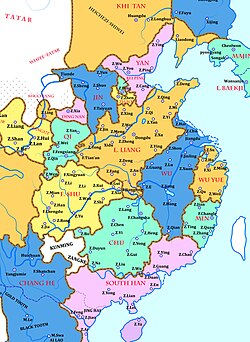Later_Liang_(Five_Dynasties)
Later Liang (Five Dynasties)
Imperial state in China from 907 to 923
Liang, known in historiography as the Later Liang (simplified Chinese: 后梁; traditional Chinese: 後梁; pinyin: Hòu Liáng) (1 June 907 – 19 November 923) or the Zhu Liang (Chinese: 朱梁), was an imperial dynasty of China and the first of the Five Dynasties during the Five Dynasties and Ten Kingdoms period. It was founded by Zhu Wen (Emperor Taizu), after he forced the last emperor of the Tang dynasty to abdicate in his favour (and then murdered him). The Later Liang would last until 923 when it was destroyed by the Later Tang dynasty.
This article needs additional citations for verification. (April 2021) |

